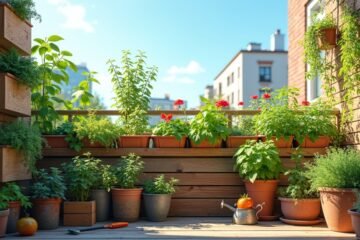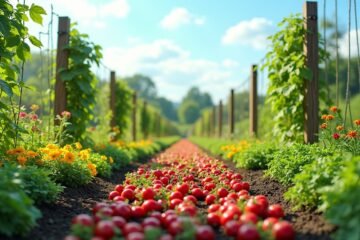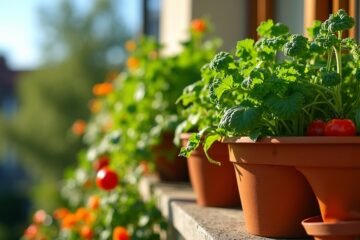Want a vibrant small garden that thrives through every season? Start by picking native plants like coneflowers in spring and zinnias in summer! Don’t forget to check your climate zone—it’s like knowing your garden’s secret handshake! Prepare your soil with compost for the best results, and use drip irrigation to keep those roots happy. Oh, and did you know marigolds can ward off pests? Stick around, and you’ll uncover even more gardening gems to boost your green thumb!
Choosing the Right Plants for Each Season
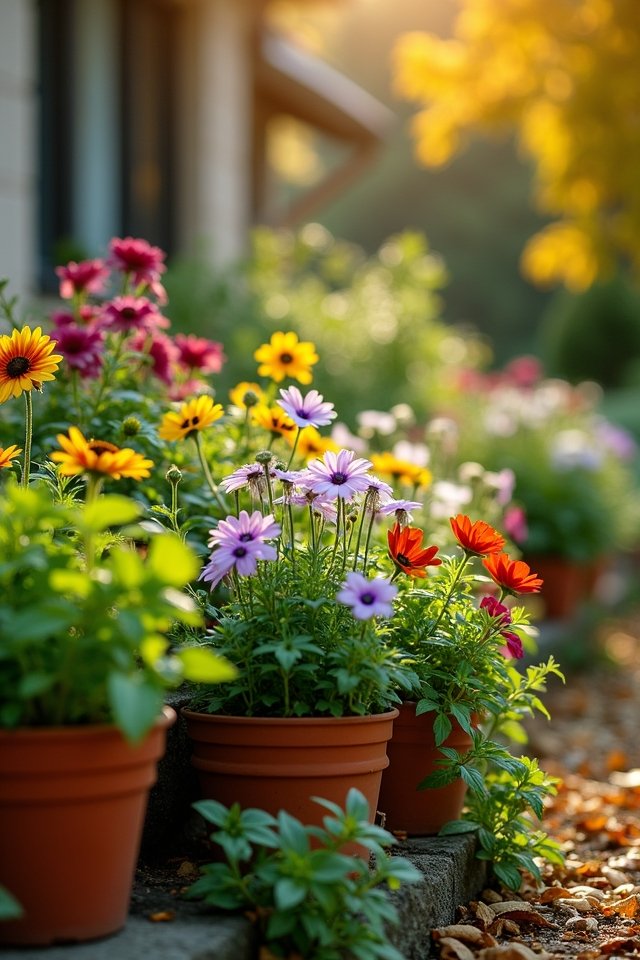
When you think about planting for each season, it can feel as tricky as juggling water balloons—one wrong move and you’re drenched! But don’t sweat it! Choosing seasonal blooms can transform your garden into a vibrant masterpiece. For a splash of color in spring, think dainty native varieties like coneflowers or black-eyed Susans! In summer, why not spice things up with zinnias or cosmos? As autumn rolls in, those brilliant marigolds and asters will keep your garden buzzing! Winter’s no snooze fest, either—evergreens offer structure and interest. By embracing native varieties, you’re not just planting; you’re creating a sustainable ecosystem! So roll up your sleeves, dig in, and watch your garden burst with life all year long! 🌿✨
Understanding Your Climate Zone
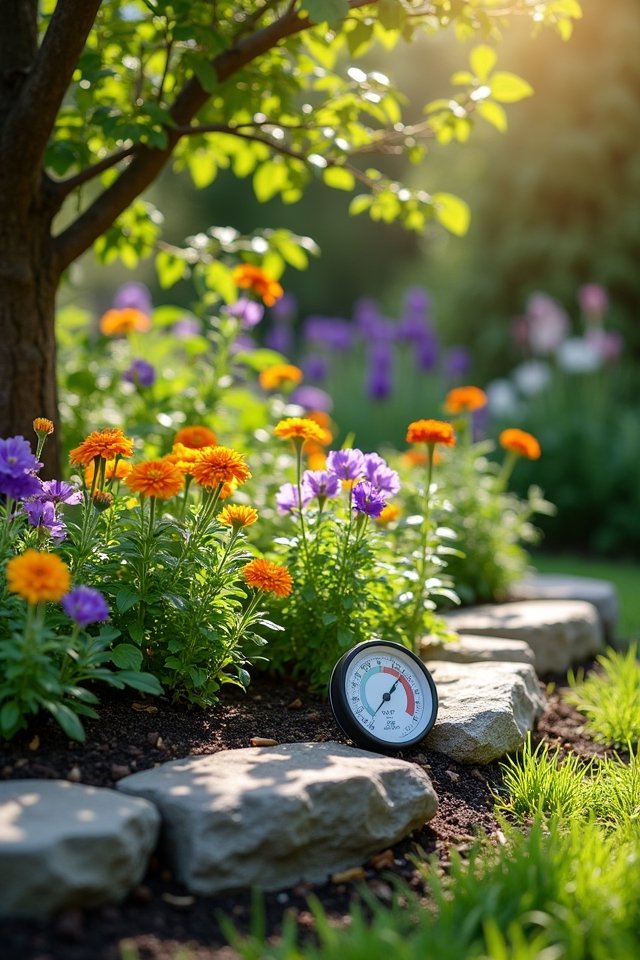
Understanding your climate zone is like having a secret map to gardening success! It helps you navigate the wild world of plant possibilities. Climate impacts, like temperature and rainfall, dictate what grows best in your garden. Check out zone maps to find your specific area—are you in a chilly Zone 5 or a sunny Zone 9? Knowing your zone means you won’t plant daisies in December or tomatoes in a blizzard! Instead, you can choose plants that thrive, like stunning asters in fall or vibrant zinnias in summer. It’s like giving your garden a VIP pass to flourish! So, grab that zone map, accept your climate, and watch your small garden blossom like never before!
Soil Preparation Techniques
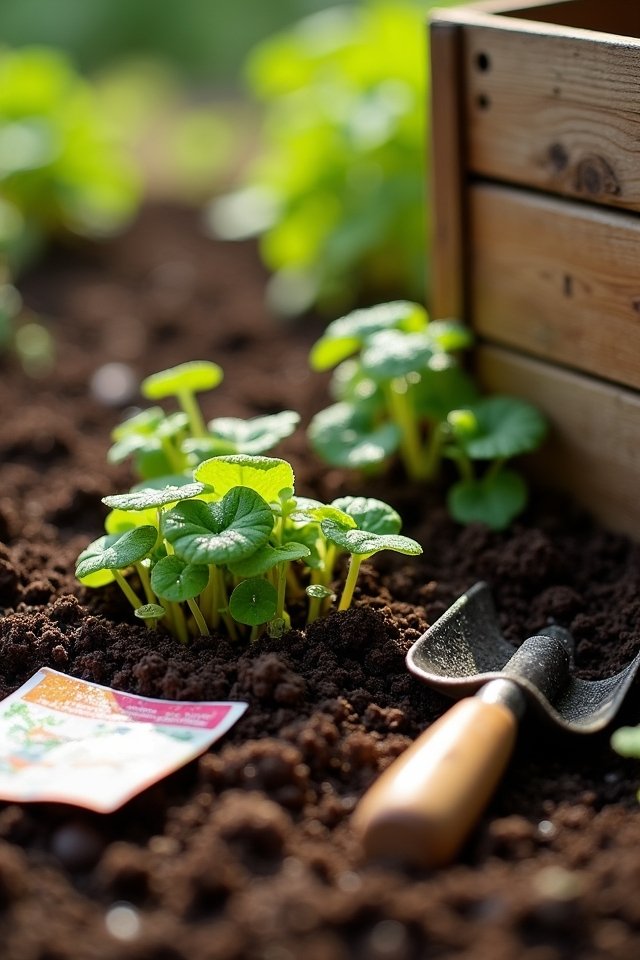
Now that you’ve got a grip on your climate zone, it’s time to roll up your sleeves and prepare that soil! Start by testing your soil—think of it as a health check-up for your garden. Grab a simple kit to uncover pH levels and nutrient deficiencies. It’s like finding out what your soil’s secret recipe needs!
Once you know the results, incorporate organic amendments like compost or well-rotted manure. These goodies turn your tired soil into a nutrient powerhouse, feeding those roots with love. Mix them in well, and feel that rich texture beneath your hands! Remember, healthy soil means happy plants, and who doesn’t want their garden thriving like a lush oasis? Let’s get digging!
Maximizing Space With Vertical Gardening
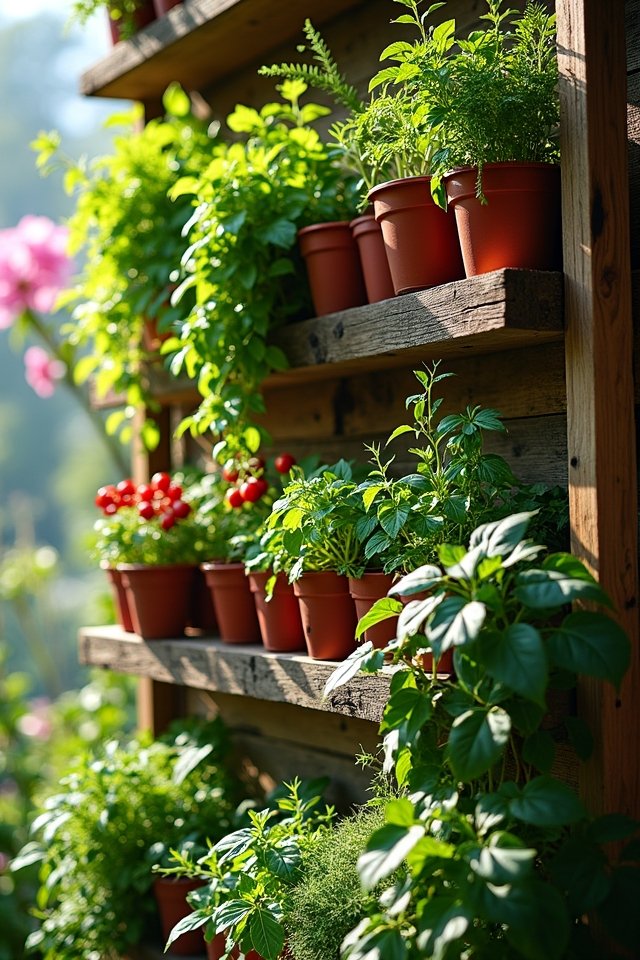
If you want to make the most of your small garden, vertical gardening can be your best friend! By embracing upward growth, you not only save space but also create a stunning display of greenery. Here are three fabulous ideas to get you started:
- Vertical Planters: Stack them up to showcase herbs or colorful flowers!
- Wall Gardens: Transform bare walls into living art with climbing plants.
- Hanging Pots: Add whimsy with creative containers that dance in the breeze.
With engaging trellis designs and clever arrangements, you’ll turn your garden into an oasis of beauty! Let your small space shine with creativity and innovation. So, are you ready to take your garden to new heights?
Companion Planting for Small Gardens
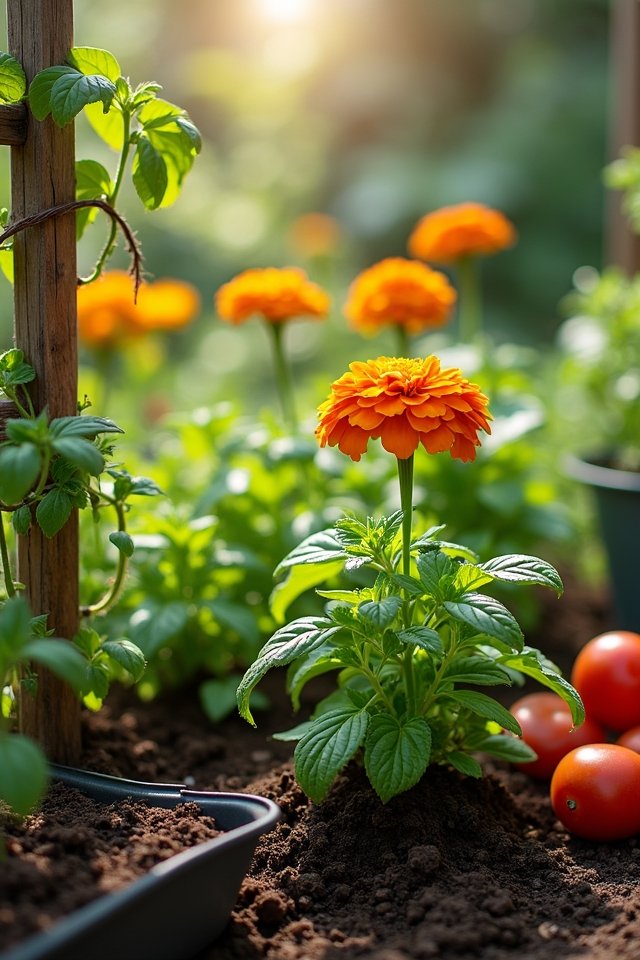
After you’ve spruced up your space with vertical gardening, let’s explore the magic of companion planting! Imagine a team of best buds helping each other thrive—plant pairings like tomatoes and basil or carrots and onions create a mini-ecosystem bursting with growth benefits. These pairings fend off pesky pests and boost each other’s flavors, transforming your small garden into a vibrant culinary paradise!
Picture this: lush tomatoes mingling with fragrant basil, all while keeping the local bugs at bay. Isn’t that a win-win? By strategically placing companion plants, you’re not just saving space; you’re crafting a harmonious garden that works smarter, not harder. So, get those pairings together and watch your green space flourish in delightful harmony!
Planting Timeframes and Schedules
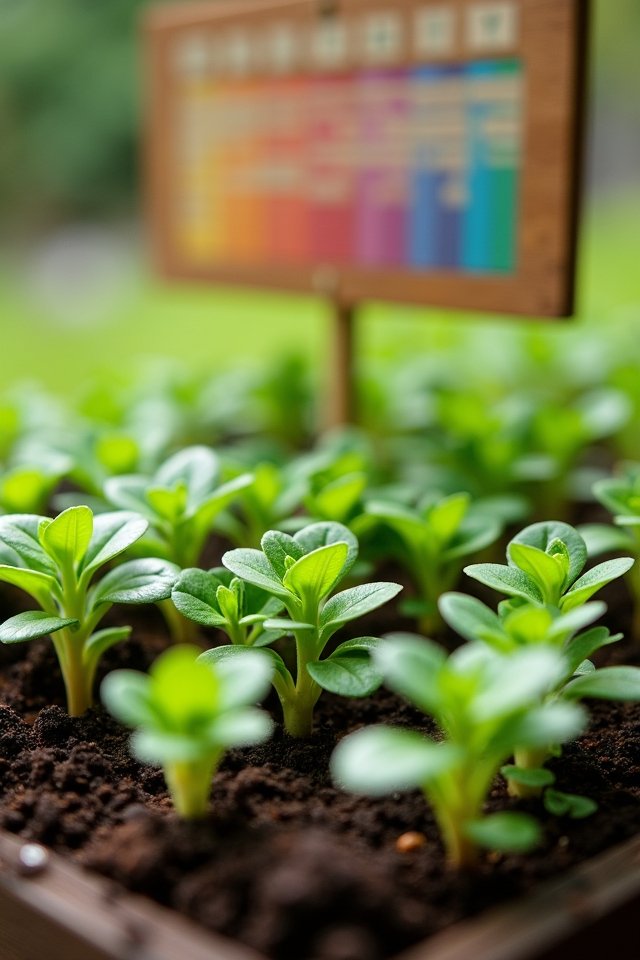
When you plunge into planting timeframes and schedules, you might feel like you’re choreographing a dance party for your garden! Exciting, right? With spring planting and fall planting, timing is everything. Picture your veggies and blooms bursting with life at the perfect moment!
Here are three key timeframes to keep in mind:
- Early Spring: Get your cool-season crops like peas and lettuce in the ground; they love that crisp air!
- Mid-Spring: That’s when you should plant warm-season delights like tomatoes and peppers—let the sunshine do its magic!
- Late Summer/Fall: Wrap up the season with heartier options, such as kale and Brussels sprouts; they thrive in cooler temperatures.
Let’s get your garden grooving! 🌱
Managing Watering Needs Efficiently
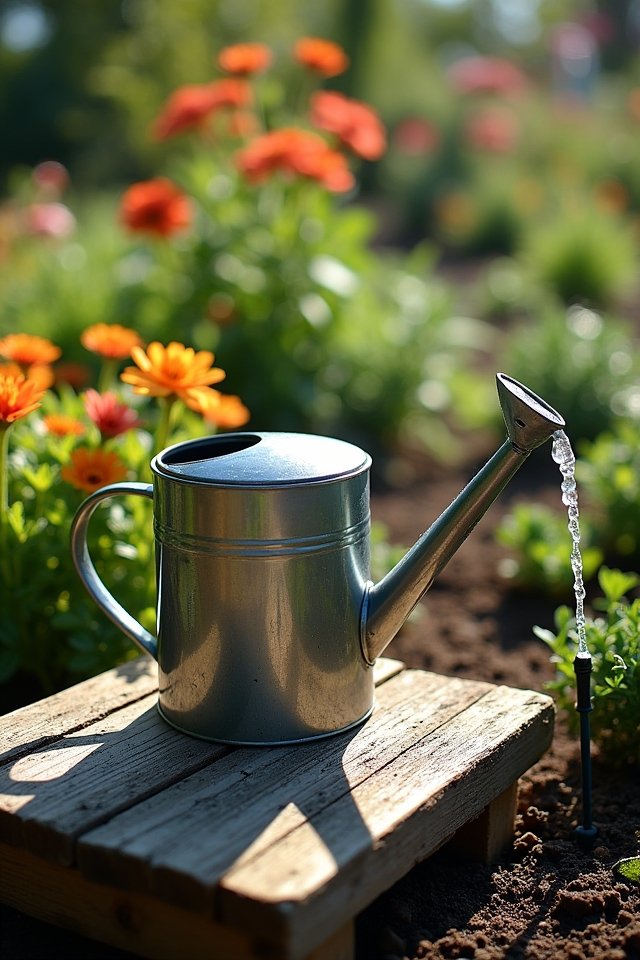
Alright, you’ve got your timing down for that vibrant garden of yours—now let’s talk watering! You want to be smart, right? Consider drip irrigation! It’s like giving your plants a cozy drink directly at the roots, minimizing waste. How cool is that? Then there’s rainwater harvesting. Imagine capturing those invigorating raindrops in a stylish barrel, turning Mother Nature’s gift into a watering treasure chest! You could water your greens and feel like a gardening superhero! Make sure to adjust your settings; a little goes a long way! Just think, you’ll be conserving water and saving on that utility bill—all while keeping your garden lush! So, why not give these innovative techniques a whirl? Your plants (and wallet) will thank you!
Using Mulch to Retain Moisture
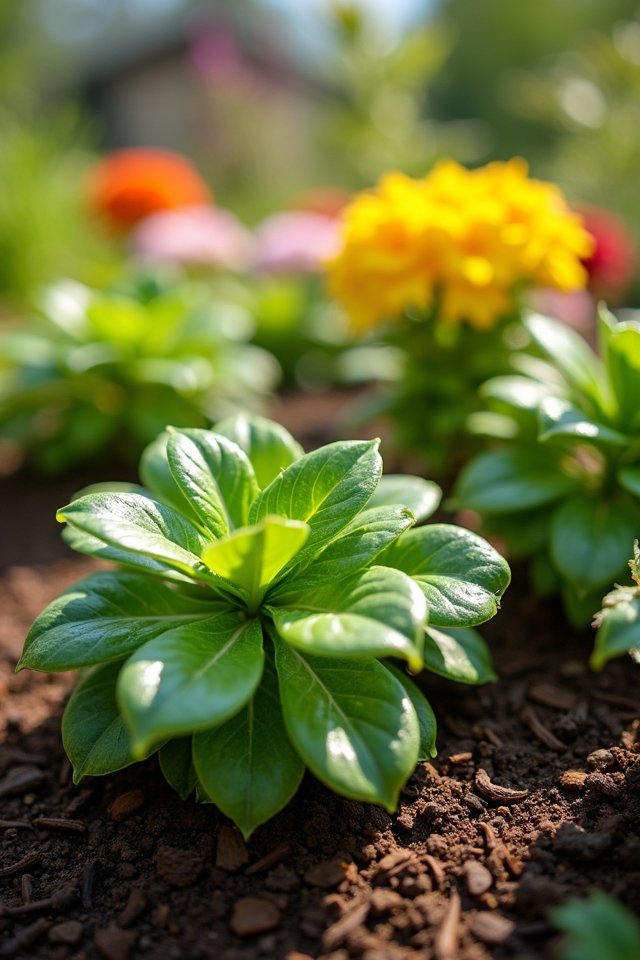
If you want to keep your garden thriving through the heat, using mulch is your secret weapon! This magical layer not only looks great but also offers incredible mulch benefits, like conservation of moisture retention. Here’s how to get the most out of it:
- Weed suppression: Mulch chokes out pesky weeds, reducing competition for water!
- Temperature regulation: It keeps soil cooler in summer, preventing plant stress—who doesn’t want happy plants?
- Nutrient boost: As organic mulch decomposes, it enriches your soil, turning your garden into a flourishing paradise!
Seasonal Pest Management Strategies
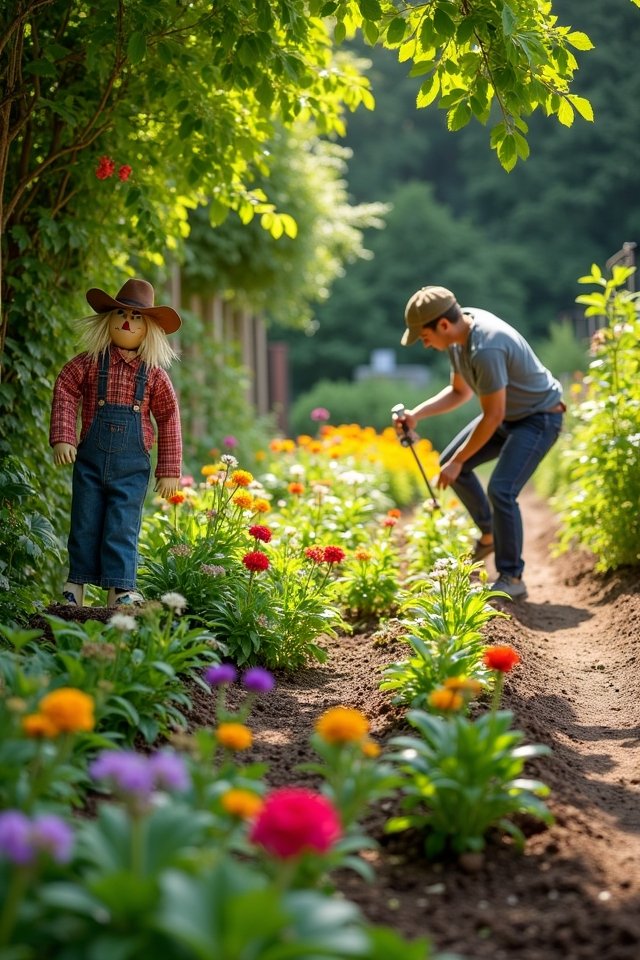
As you immerse yourself in the joys of gardening, don’t let pesky pests turn your paradise into a battlefield! Instead, adopt innovative organic solutions that keep your plants thriving. Think of ladybugs as your tiny warriors; they devour aphids like candy! Introducing natural predators like lacewings can transform your garden into a pest-fighting dream.
Create a fragrant barrier with marigolds, which deter unwanted guests while looking gorgeous in bloom! And don’t forget homemade sprays with garlic or chili—these spicy potions can make pests think twice before invading.
Harvesting Tips for Small Crop Yields
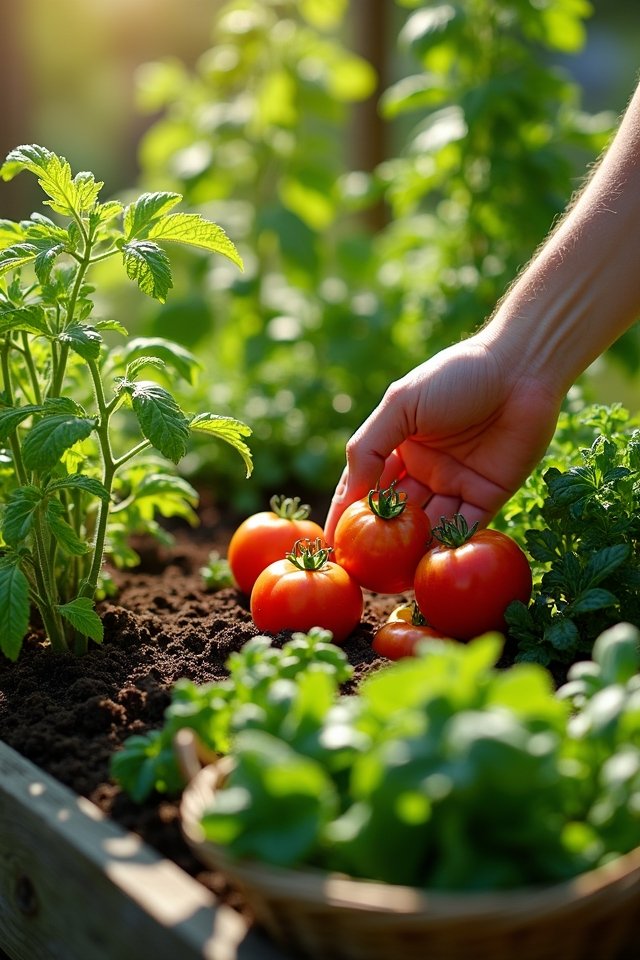
When it comes to harvesting small crop yields, timing’s everything! You don’t want to miss that perfect moment when your veggies shine! To optimize your yield and enjoy the fruits of your labor, consider these insightful tips for a bountiful harvest:
- Harvest early! Early veggies often taste sweeter, like a burst of sunshine on your palate.
- Rotate your crops! It’s like giving your plants a mini-vacation, preventing soil depletion.
- Pick at the right time! Checking daily can make or break your lettuce or tomatoes’ flavor.
Frequently Asked Questions
How Can I Attract Pollinators to My Small Garden?
Wanna invite a buzzing party to your garden? Start by planting native plants like coneflowers and black-eyed Susans—they’re like a siren call to pollinators! Don’t forget flowering herbs like basil and oregano; their sweet scents will draw in bees and butterflies. Create cozy nooks by adding some colorful stones or decorative pots; it’ll be like a VIP lounge for your tiny garden guests. Pollinators’ll thank you for the warm welcome!
What Are the Best Tools for Small Garden Maintenance?
When it comes to small garden maintenance, you can’t go wrong with a trusty hand trowel and pruners! They’re like a gardener’s best friends. Don’t forget soil amendments like compost—your plants will thrive with that rich boost. While you’re at it, master those pruning techniques, trimming back overgrowth to let the sun in! Who knew garden care could be so rewarding? Immerse yourself and watch your tiny Eden flourish! It’s gardening magic!
How Do I Extend My Growing Season?
Want to stretch your growing season like a rubber band at a carnival? You’ve got options! Consider adding a greenhouse—it’s like giving your plants a cozy sweater during chilly nights. With those greenhouse benefits, you can keep the warmth in and the frost out. You can also use row covers to protect tender plants from unexpected chills. Don’t let winter take your veggies! Welcome the innovation and extend that garden glory!
Can I Plant in Containers for Better Space Management?
You can totally adopt container gardening for fantastic space optimization in your small garden! Picture vibrant pots bursting with colorful flowers or delicious herbs. You can even stack them like a delightful tower of plants! This way, you’ve got plants thriving in every nook! Remember, using varying sizes and shapes adds visual interest, making your space pop! Plus, who wouldn’t want a mini garden in every corner? Go on, get creative! Your plants await!
What Are Common Diseases Affecting Small Gardens?
You’re not alone in battling pesky diseases in your small garden! Common culprits like powdery mildew and root rot love to wreak havoc. To fend them off, you need a solid plan for disease prevention and effective pest management. Keep your plants well-spaced, like personal bubble boundaries, and rotate your crops to confuse those sneaky pathogens. Remember, a happy plant is a healthy plant! After all, wouldn’t you prefer gardening over fighting the plant plague?
